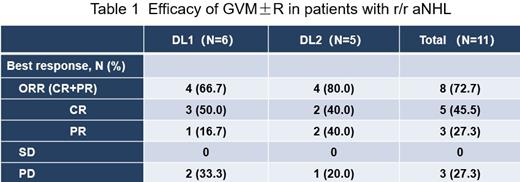Background: In patients with relapsed/refractory (r/r) aggressive non-Hodgkin lymphoma (aNHL), achieving a response to salvage therapy is a crucial predictor for long-term survival, as only chemosensitive patients have the opportunity to undergo autologous stem cell transplantation. Mitoxantrone hydrochloride liposome (PLM60) has shown good efficacy and safety in r/r peripheral T-cell lymphoma (PTCL) based on a prior study, with an objective response rate (ORR) of 40.7% and a complete response rate (CRR) of 20.4% (2020 ASH abstract 42). To determine the appropriate dosage of PLM60 in a multi-drug combination chemotherapy, we conducted a phase I clinical study aiming to explore the maximum tolerated dose (MTD) of PLM60 when combined with gemcitabine, vinorelbine, with or without rituximab (GVM±R). This trial was registered at www.clinicaltrials.gov as NCT05299164.
Methods:The study was a prospective, single-center, single-arm, 3+3 dose-escalation study involving patients aged 18-70 years with r/r aNHL. PLM60 was administered on day 1 at four different dose levels (DL) (DL1: 16 mg/m 2, DL2: 18 mg/m 2, DL3: 20 mg/m 2, DL4: 22 mg/m 2), gemcitabine on day 1 and 8 at 800 mg/m 2, vinorelbine on day 1 and 8 at 20 mg/m 2, and rituximab on day 0 at 375 mg/m 2 (only administered in CD20+ lymphoma based on the investigator's judgment). The treatment was repeated every 21 days. Up to 6 cycles of therapy were planned. After the first cycle, dose-limiting toxicity (DLT) was assessed to determine the MTD of PLM60 in the GVM±R regimen.
Results: As of July 15, 2023, the study had enrolled 12 eligible patients (DL1: n=6, DL2: n=6), with different aNHL subtypes, including 6 with diffuse large B-cell lymphoma, not otherwise specified (DLBCL, NOS), 3 with angioimmunoblastic T-cell lymphoma (AITL), 2 with PTCL, NOS, and 1 with sezary syndrome (SS). The median age of the patients was 49 years (range, 23 to 69), with 41.7% being male. All patients had advanced-stage disease, with 33.3% in stage III and 66.7% in stage IV. They had received a median of 2.5 lines of therapy (range, 2 to 7), and 91.7% (11/12) of patients had received anthracycline-containing chemotherapy in their prior treatment. All patients with DLBCL, NOS had received rituximab during their prior therapy. 66.7% (8/12) of the patients were refractory to their last line therapy, and 2 out of the 6 patients with DLBCL, NOS experienced relapse after anti-CD19 chimeric antigen receptor T-cell (CAR-T) therapy.
During the study, two patients experienced DLTs of grade 4 neutropenia lasting for more than 7 days, with one occurring in the DL1 group and the other in the DL2 group. In response to these observations, an additional three patients were enrolled in each of the groups. The most common grade 3/4 TRAEs with an incidence ≥10% were leucopenia (91.7%), neutropenia (83.3%), thrombocytopenia (66.7%), anemia (41.7%), febrile neutropenia (25.0%), pneumonia (25.0%), and hypokalemia (25.0%).
With a median follow-up of 2.5 months, 11 patients were evaluated for efficacy, showing an ORR of 72.7% (95% CI 39.0% to 94.0%) and a CRR of 45.5% (95% CI 16.8% to 76.6%). In the DL1 group (16 mg/m 2), the CRR was 50.0% (3/6), and the ORR was 66.7% (4/6), while the DL2 group (18 mg/m 2) had a CRR of 40.0% (2/5) and an ORR of 80.0% (4/5) (Table 1). Among the DLBCL patients, the CRR was 60.0% (3/5), and among AITL patients, the CRR was 66.7% (2/3). Patients with PTCL NOS and SS achieved partial responses (PR). Two DLBCL patients who had previously received multiple lines of therapy, including anti-CD19 CAR T-cell therapy, achieved CR after GVM±R treatment.
Conclusions:The GVM±R regimen exhibited manageable safety and encouraging efficacy in patients with r/r aNHL, despite the fact that the majority of these patients had received anthracycline-containing chemotherapy in their previous treatment. The trial is still ongoing to determine the recommended phase 2 dose for the subsequent phase 2 clinical study.
OffLabel Disclosure:
No relevant conflicts of interest to declare.
Mitoxantrone hydrochloride liposome (PLM60) is an anthracycline anti-tumor drug approved by the National Medical Products Administration (NMPA) for the treatment of relapsed or refractory Peripheral T-cell Lymphoma patients who have previously undergone at least one line of therapy.


This feature is available to Subscribers Only
Sign In or Create an Account Close Modal